The Nihilist Spasm Band | Interview
The Nihilist Spasm Band was formed in London, Ontario in 1965 and soon became one of the weirdest music collective to the present day.
In the following interview we will discuss their long career in improvisation. The very beginning of this group can be attributed to Greg Curnoe (1936-1992) who was a film director that needed a soundtrack for his film.
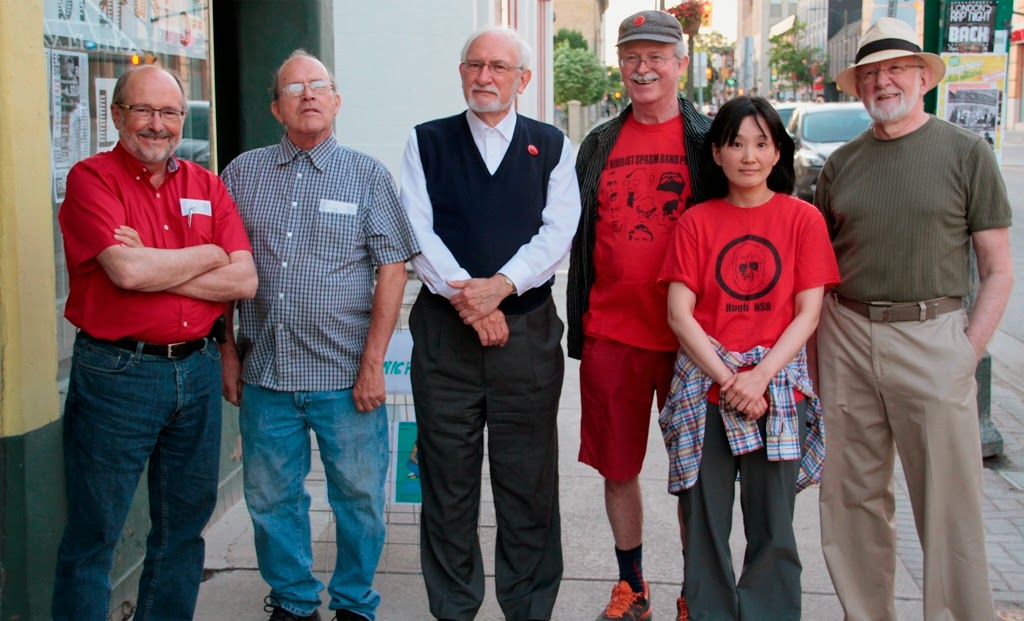
Greg Curnoe co-founded Nihilist Spasm Band in 1965 to make a soundtrack for his movie. What was the name of the film? Was it ever released?
Bill Exley: The title was “No Movie”, and it included scenes from Nihilist Lodge in Port Stanley, Ontario, which our group rented for two summers in 1965 and 1966, and also scenes from the first Nihilist Banquet, which included a formal programme of speeches about the history of nihilism and other toasts to the past and future, together with the singing of “God Save the King” (he had died in the early ’50s). The movie also included scenes from the first Nihilist Picnic, which featured races such as “women’s kick the shoe”. (The 50th annual Nihilist Picnic was held on September 7, 2014.) There were also scenes from a lacrosse game and people drinking in the York Hotel. “Connexions”was another movie made by Greg about people and places in London, Ontario.
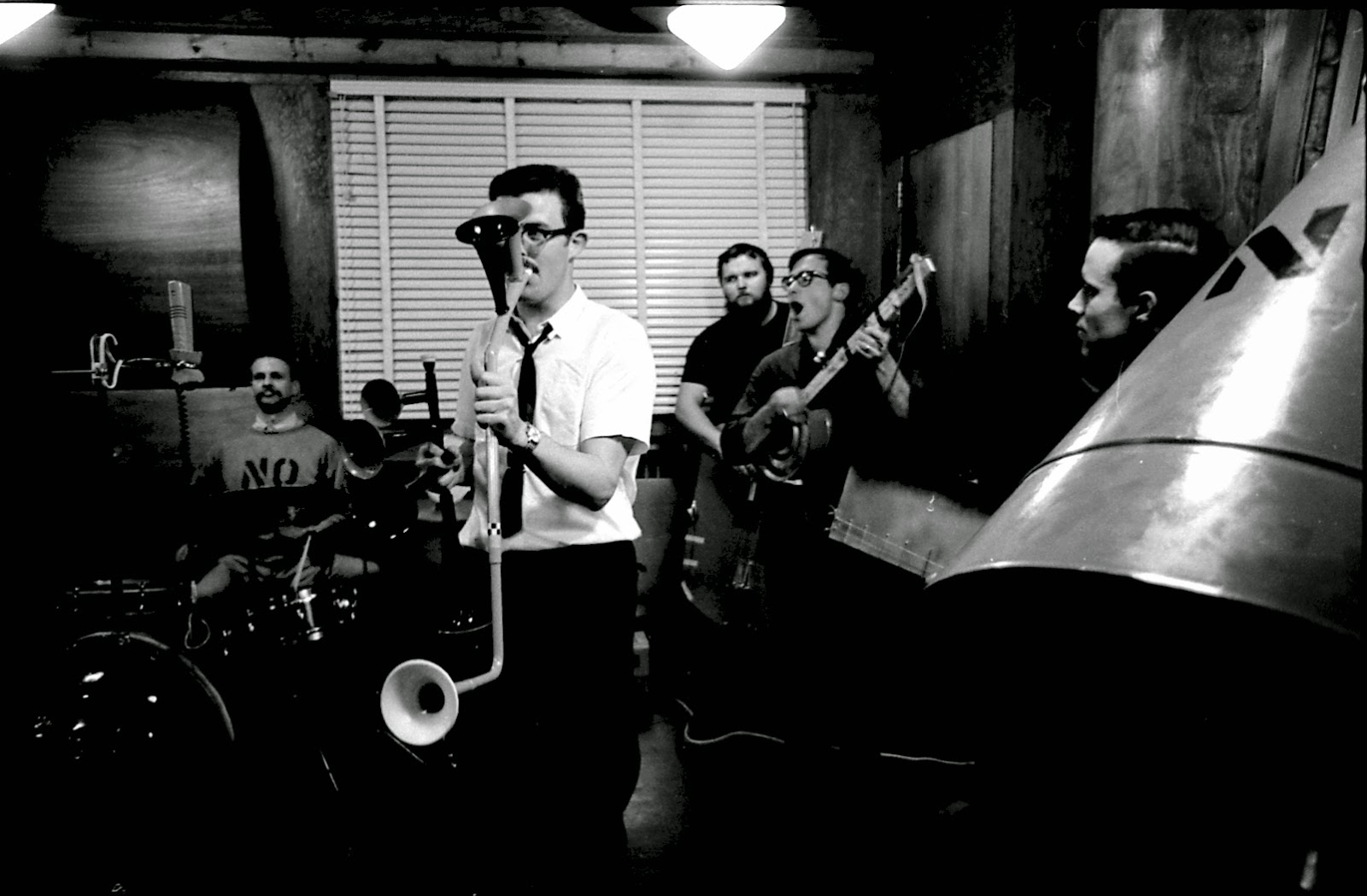
Murray Favro: The movie although Greg’s project was also a collaboration. Hugh McIntyre (later a band member) who worked as a film librarian had much to do with making it; he had the connections to get editing done on “No Movie”. He also supplied cuts of a Farnborough Air Show as well as undersea creatures like octopuses and sea snakes. I am unsure but I think it was Drew Gilles of the National Film Board who did the actual film editing because neither Hugh nor Greg could operate editing equipment. The first kazoo involved in our nihilist activities was at the first nihilist picnic in the same location where some of the filming for the movie was done.
When Greg saw the film cuts of all us London people playing Kazoos at the beach, that gave Greg the idea to use a kazoo sound track. The soundtrack was recorded in Greg’s studio in that fall or winter. There were a lot of us and I believe we watched the film as we played the soundtrack. It was so much fun to see it and hear us make noises. And best of all it needed no synching up it would always connect up somewhere interesting. Like a sea creature cut would sometimes line up with a weird sound or a jet would make a near fart sound that exploded into wild noise. It worked as a separate tape soundtrack not actually on the film. The movie was shown in art galleries across Canada and I think Greg had it in a local film co-op who made it available. It was never released; it remained an experimental art movie. The chaotic sounds in that sound track had an interesting high energy to it that got us rather jokingly talking about what if we formed a band. Hugh thought more of it than a mere joke because within a few days he showed up at my studio holding a small Kazoo and a funnel he wanted to make a louder kazoo for the band we were talking about. I could not join them up so we went to Greg’s studio with his power drill and somehow joined the two things together. Greg got excited about having us form a band. And was soon rounding up people to talk about it. Art Pratten was there within a day or two and Greg got John Clement who had already made a 12 string guitar as well as Archie Leach who assured us would be a good addition since he was known to hang out 3rd story windows and shout insults to people walking by on the sidewalk below. Archie always wore a suit coat and tie and was working as a bookkeeper. He seemed a contradiction and probably a danger to himself but anyway we tried him and his harmonica, which didn’t seem to work with our stuff. He gave up on the harmonica and invented a slide clarinet that was loud and perfect for our band. Exley and Boyle were in it by then too; they would come to London on weekends from their jobs out of town. Billy Exley however did not want to ruin his teaching career so anytime we were to play in public he would wear a monkey mask. Greg, Boyle and Pratten made kazoos and we all collected used drums. Hugh had someone make him what he called a ‘gut bucket bass’ that consisted of a 5 gallon metal drum with one string and a levered neck to change the notes as he played. I played drums some of the time and a thing with strings on it that needed amplification. Exley sang through a huge megaphone on a stand. This was the beginning before amplification that soon came as I made guitars and Hugh had an electric bass made. By the time of our Allied recording we were all amplified.
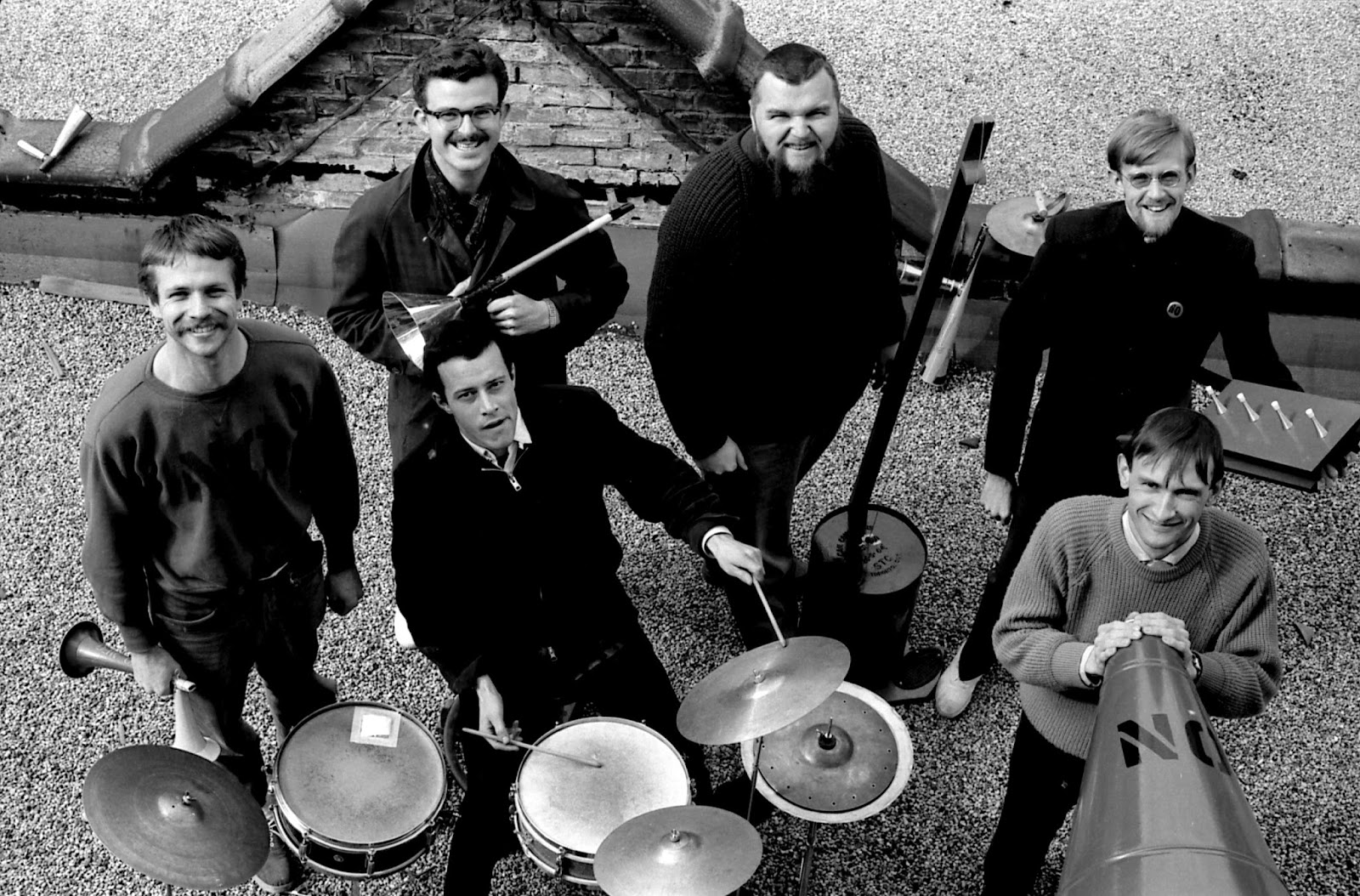
Art Pratten: “No Movie”, it did get some circulation and then became a myth with a lost soundtrack.
John Boyle: It was released and later the soundtrack was lost without a trace.
Do you know his original idea behind making an improvisational soundtrack?
Art Pratten: A soundtrack was needed and like everything else at the time if you wanted or needed something you just went out and did it. We had some kazoos we obtained more and a group of about 15 to 20 sat around in a circle and kazoo’d.
John Boyle: Someone found some red and black (actually red and navy blue) 25 cent kazoos and we thought they looked like Nihilist colours of red and black. People sat around in Greg’s studio (he was a painter) and threw ideas around. He decided on his friends improvising on kazoos because the film was about connections among families and friends and the interdependence of people.
How did you know him and where did you all meet?
Bill Exley: I met Greg at a party on Talbot Street in London, Ontario in January, 1961. I had brought a recording of Ravi Shankar classical Indian ragas, and he borrowed it from me and invited me to his studio to get it back. Greg was then interested in new ideas of all kinds, and he retained this intellectual interest in a variety of topics all his life. He was interested in jazz, for example, but he also listened to French eighteenth century music, recordings of Ezra Pound and other twentieth century poets, and he read writers like George Grant, who had written “Lament for a Nation” in 1965, a book about the importance of Canadian nationalism. Through most of the almost 50 year history of the Band the members conversed, not only about making noise, but also about politics, arts, ideas, etc. This kind of discussion was a part of the vitality people felt when they heard us.
Murray Favro: I met Greg by going to his studio when I was in my last year in art school. I wanted to see what a studio looked like and how do I get to rent one once I finish art school. My teachers advised me to get a studio and begin working. They knew Greg was back from Toronto and started working in a studio in London. Ron Martin, another art student, knew Greg and had suggested we should drop by on our way back from a trip to a Picasso show in Toronto. I was impressed by Greg’s artwork and studio. It was at Greg’s studio that I met other people who eventually became part of the band. Greg is the only artist I have met who could paint and carry on a conversation with a number of people. He had a lot of chairs to sit on and lots of people came and went as he worked. Every Saturday Hugh would buy a few cases of beer. They went into a big thing with ice in it. We sat around and had a few beers, people would show up a lot of nurses someone had met and other beautiful young ladies would arrive, Greg would put on records and it became a party. People who were around in the creative influence of that time went on to do interesting things elsewhere, one person went to head the national film board, another went to run and edit Arts Canada Magazine. Tony Pennicott later became premier of the Yukon. The point I am making is there was a cultural scene of creative and interesting people and lots of them, and a place like Greg’s studio was important as a meeting place.
Art Pratten: Greg and I grew up in the same neighborhood, went to a couple of the same schools and took newspapers from the same depot.
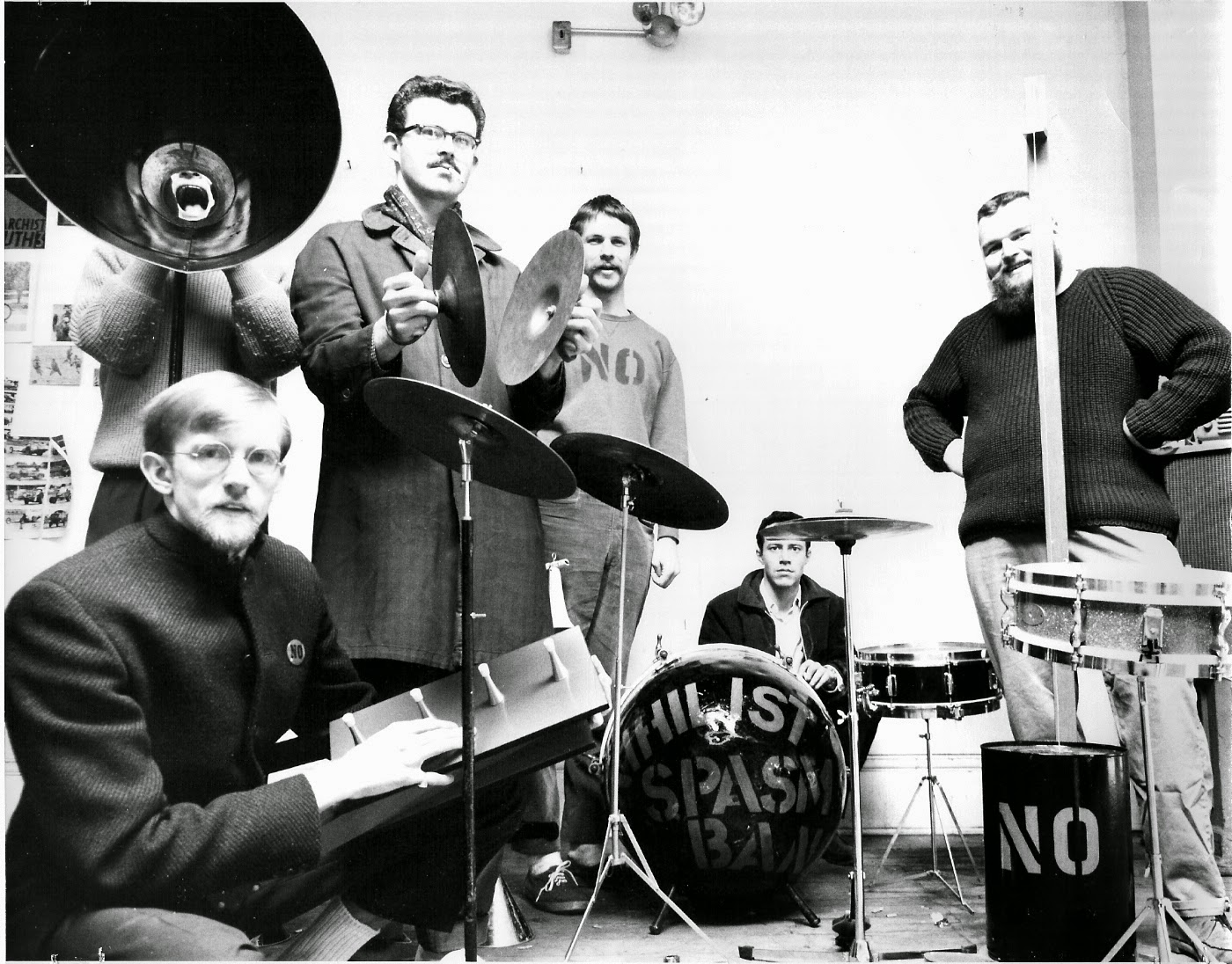
John Boyle: We were all independently friends with Greg or with one or another of his friends, some from early childhood. We met in his loft studio in downtown London. I was introduced to Greg by my friend Bob McKenzie in 1960. Greg took an interest in me because I had decided to become an artist.
Curnoe was also a member of London Regionalism. Can you tell us what that was about?
Murray Favro: London Regionalism was a way of thinking for Greg not a thing he belonged to. The way I understood him was the way he emphasized that art need not emulate what is happening in a place like New York but is as relevant no matter where it is done and need not emulate anything. In short Greg needed other creative people to talk to in his own environment. He valued the Nihilist Spasm Band because it was not like mainstream culture, and would be an honest export from this region and as relevant as any other creative works from anywhere else. We are, however, not his invention. I was showing my work in other cities within a year of getting my first studio here in London. Greg did encourage people to stay here though which actually is OK but rather unrealistic because the world was becoming very mobile at that time and every artist that lived in London then is long gone except myself. The concepts of the band are no leader, no planned musical direction where everyone plays what they want. We are all individuals in the band and one of us (Bill the singer) wants some predictable words and structure to our song pieces. We do restrain ourselves at the beginning of his reading of the lyrics. But in the past he used to insult the audiences but now likes them and insults band members to be quiet while he reads the important words. We agree with him but just find it difficult to be quiet.
Art Pratten: The idea grew out of the belief you could find inspiration and resources locally and since none of us were interested in leaving necessity was turned into a virtue.
John Boyle: There was no London Regionalism organization. Greg was from London and loved London. He thought London was as relevant and important culturally as any other place, including New York, Paris or the other London. This was revolutionary thinking for many of us, to love the region you came from. We lived and continue to live in a colonial culture that tends to think that anything produced here is inferior to things produced in the Mother or Dominant culture, e.g. England, France and the United States.
Did any of you have any musical knowledge?
Art Pratten: We all had a knowledge and appreciation of music, but no formal training.
John Boyle: In spite of what some of us may claim, the answer is NO!
What do you think was the main inspiration and influence for Nihilist Spasm Band back in the ’60s?
Bill Exley: London, Ontario was a conservative (in the bad sense) and unadventurous kind of place, and I think this environment created in many young people the desire to be hostile.
Murray Favro: In the 1960’s I cannot think of any influences on the band except to have fun making energetic sounds.
Art Pratten: I think the building of the instrument was the catalyst for the band. We could have gone on listening to music, arguing about music and kazooing forever but when we started modifying kazoos and building new instruments we really started to compete making a noise and this created a “Noise Band”.
John Boyle: We each individually had our own tastes, interests, influences and inspirations, not necessarily shared by any of the others. We each brought ours to the group. All of us were necessarily influenced by the others’ influences whether we liked them or not, simply because we were forced to deal with them in our group improvisations until we found something we were more or less happy with. For example, a few of us were aware of New Wave free jazz like Ornette Coleman, Albert Ayler or Cecil Taylor, while others liked Mediaeval Troubadour music or English madrigals, or the Rolling Stones. We learned to throw our licks at each other and bounce them back and forth. If you hated some things you tried to drown them out with your sound, and thus we became noisier and noisier.
What influences you these days?
Murray Favro: Our influences have always been the moment and the space we play in along with our equipment and listening to the other members. It is a very immediate experience and not a real influence.
Art Pratten: Just about everything.
John Boyle: I just try to listen carefully to the many improvisers we meet at festivals and performances and learn from them when there is something that might benefit or change my playing. I like much of what I hear , but have not yet heard anything that would radically change what we do.
What was the scene in London, Ontario back then? Where did you hang out?
Murray Favro: At first we hung out at Greg’s studio but it soon changed to be at the York Hotel. And that also was where the band began playing every Monday night. We packed the place and we also got a lot of press coverage outside London in magazines and newspapers. It was on one of these Mondays that Bosswell, head of Allied records came to hear us and during an intermission talked to us outside the York. He wanted to bring out a record of us. Soon we recorded the album in Toronto. That is how we got the record deal by Bosswell coming himself to hear us.
Art Pratten: Greg’s studio was the real centre. It was open and admission was a passion for something…anything… art, literature, theater, movies, car racing, boxing, girls, beer and parties. Not necessarily in that order.
John Boyle: London was extremely exciting in the mid 1960’s for young visual artists in particular. Greg Curnoe had moved back to London after art school and found a large loft studio. He and a group of friends opened a small cooperative gallery called Region Gallery showing uncompromising local work. He also started Region Magazine where provocative local thinkers published their thoughts and poetry. 20/20 Gallery followed, and 20 Cents Magazine. Jack Chambers moved back to town from Spain and began painting full time in his studio. Local musicians were playing in various pubs, and the York Hotel agreed to let the Spasm Band play on Monday nights. Artists, writers, academics, and musicians met and socialized in Greg’s studio and in other artists’ lofts, exchanging ideas and dreaming up projects.
Allied Records was a pretty big record company and it’s quite unusual they got you signed and managed to release your LP titled ‘No Record’. Did Greg Curnoe have any ties with them?
Murray Favro: I remember Allied Records was some offshoot of a big label, it was based in Canada Boswell actually owned the tapes himself. He was out to record the next thing to happen in music and was recording all the experimental stuff he could in case it may be one of them that sets a new direction in the music business. The Allied was doing an early scouting for new directions.
He would not have been in the least interested in us if he noticed influences by other bands in what we did. The Allied Corporation is the real name to search out on the web otherwise you will end up only finding Allied Recordings in western USA that are not the right Allied. Greg had no ties with Allied until later when they began negotiating with us and I got the job of designing and doing artwork for the cover of the record jacket. Someone else did liner notes, (I think it was Hugh) and do not know who designed the back of the jacket; it may have been assembled by the printers in Toronto with material we sent them.
Art Pratten: Not that I know of. A guy showed up on a Monday night and asked if we were interested in making a record and we said “what will it cost us?” he said “nothing” we said “sure why not”.
John Boyle: He knew some other artists who were recording with Allied, and probably that is how Allied heard about the NSB. Allied was looking for new experimental bands and individuals to record. I think they thought they would discover people who might become big in the unpredictable psychedelic music world of the 60’s. They asked us to record.
I would like it if you could tell us what are some of the strongest memories from recording this album. Where was it recorded and what instruments were used? You had your own ‘noise-machine’.
Murray Favro: It was done as if a live performance one take no rehearsing, which we cannot do anyway. We gave titles later for some of the tracks. I remember my Toronto art dealer being there with his secretary, (he had taken an interest in exhibiting and selling unusual guitars I had made a few years earlier and always was asking about the band and what we were doing. He had not heard us though until that recording day. He could not contain himself from jubilant laughter; he recognized pure creative activity was what was going on. He liked it so much that he right then ordered two cartons of the albums before they were made. I asked him later why he bought so many and Carmen replied ‘they will be worth a lot some day’. Some of them eventually sold for hundreds of dollars each. I played a homemade version of a guitar with no frets on it; also the neck could be bent to change a note while playing. Look up my name on google and on images the guitars are there. You mention a ‘noise machine’, I never heard of any ‘noise machine’ unless it was that thing Art Pratten tried out with door stoppers on it.
Art Pratten: The recording session is very much a blur for me except for Archie who was hyper and shouted out some lyrics of his own. That is where ‘Dog Face Man’ comes from.
John Boyle: We recorded the record in a studio in broadcaster Bill Bessey’s basement in Toronto. There were several kazoos, drums and the bass. The guitars had replaced a couple of kazoos. Archie Leitch had made a slide clarinet and Bill Exley played a theremin that a friend had built for him. I remember a wife or 2 tickling Bill’s feet so he could make laughing noises.
What meaning has the material on the album? ‘Destroy the Nations’ has some very provocative lyrics…
Murray Favro: I think ‘Destroy The Nations’ had provocative lyrics as you suggested it does. But when I actually listen to it implies that countries mentioned have lost any idealism or Nationalism has no meaning or value any longer. It is about doing away with the failed concepts of nationalism. But then again another of our songs may imply the opposite on later songs like “No Canada” where a line mimics the Troggs in saying “Canada I think I love you,. But I want to know for sure”. Those provocative lyrics are fun to say and fun to hear. Too much syrup is not good for anyone.
Art Pratten: They were supposed to be provocative and humorous.
John Boyle: All of the band members contribute lines, words, ideas. We would sit around in an artist’s studio or in a restaurant and shout out our contributions with Greg writing them down. We were usually trying to be funny and outrageous, but not serious. Some of us were anti American, others were not. Some were almost entirely non political. Our sense of irony made things seem more revolutionary than they actually were. Over the years some of us have learned that ironic comments are entirely lost on many members of the public.
How about the cover artwork? Who made that?
John Boyle: The photo is of Hugh McIntyre, our bassist for 39 years until his death. Some friends had bought him a North African Bernuse, a long gown, which he wore occasionally. The band members agreed on the title. I was not involved in the design. Was it you, Murray?…, or Art?
Art Pratten: That was all Murray.
What happened after the record came out? It actually had some promotion & distribution since it was released on a bigger record label, right?
Murray Favro: Your question about a bigger record label is perhaps a different Allied than the one Boswell was head of. (www.discogs.com/artist/519321-Jack-Boswell) confusing it was Allied. My impression was that they spread the albums thinly around the world to see what might happen somewhere. It was on its own in record stores where they did sell what they made then Allied sat back to see what might happen. Something did but it was a spread out audience and what eventually happened ten years later was someone offered to make a new album and the same has happened other times through the years and by now we have made a lot of albums, perhaps because of that first one with Allied.
Art Pratten: We were jubilant. The Band got about 50, we each took a couple copies and bragged to our friends about it and promptly abandoned the rest at Greg’s studio.
John Boyle: Nothing much happened. It did receive some airplay, and we got a few invitations to play on university campuses. Gradually copies found their way around the world and began to build our international underground reputation. It took a long time before we got any feedback. One copy made its way into the hands of Toshiji Mikawa and Jojo Hiroshige of Hijokaidan in Japan in the late 1980s. In 1991 we received an invitation sent to the mailing address on the record in London to record on Alchemy Records, Jojo’s label in Osaka.
What can you say about concerts? With whom did you share stages?
Murray Favro: The NSB has played numerous concerts and music festival things and tours, so many places that I sometimes mix them up when I try remembering what happened where.
Audiences today are better listeners than the ones in the 1960’s and more musicians can play along with us now also it seems that in the past they always wanted to bring some concept to try out with us. These ideas never worked, now many musicians can just play with no plan. It’s all listening and reaction. What they do will be a surprise to them. Some people I remember were Maynard and the Mocking Birds, Mike Snow, Lighthouse, Sonic Youth, Joe McFee, Joe Joe and Junko, to name a few. I have never listened to weird stuff.
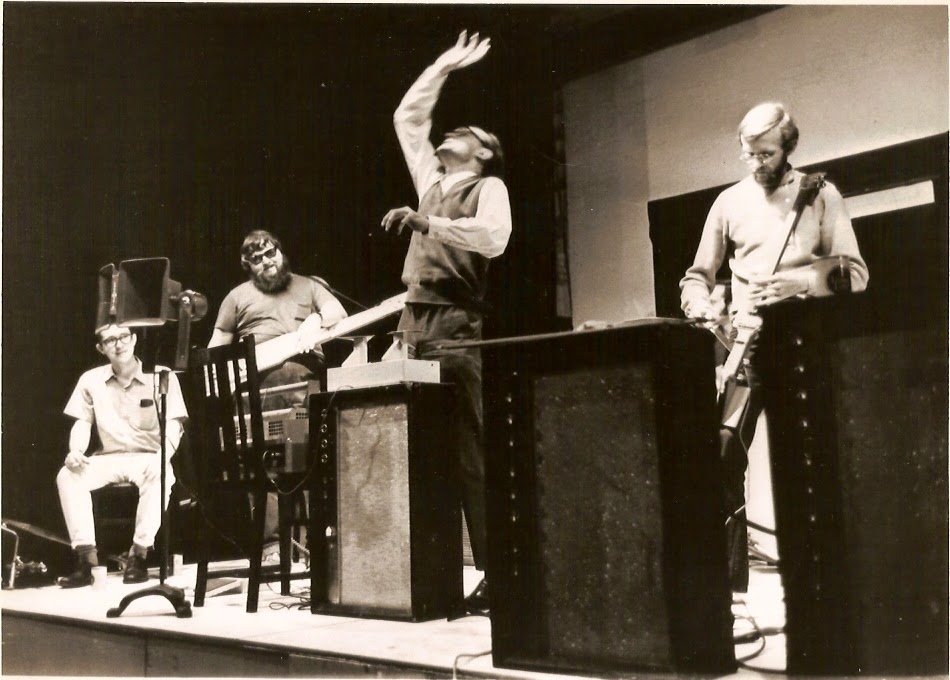
John Boyle: For 20 years we mostly emptied theaters and bars. In the 1980’s we played in Quebec for the first time and received an enthusiastic response for nearly the first time ever. We were shocked. In the 1990s we began to tour internationally for the first time since 1969. Also, the No Music festival was started by some young enthusiasts and fans in London. There were 5 festivals in all. We played with many of the world’s leading improvisers, including Fred Van Hove, Thurston Moore, Lee Renaldo, Hijokaidan, the Incapacitants, Ken Vandermark, Alexander Hacke, Joe Mcphee, REM, and countless others. We were always impressed by the down-to-earth civility and friendliness of the musicians, but we were never overawed by them. Thankfully, we always felt like equals. Of course, all humans are equals.
You even went to Europe. What’s the story behind that?
Murray Favro: We have gone to Europe many times on tours and played in festivals there. When you ask what the story is about going to Europe you must be referring to the first time we were sent as Canada’s part in an art cultural thing in Paris’s main contemporary museum where other countries sent stuff to hang on walls we played outdoors and the street audience seemed to enjoy it. Then we went to some art school in London England and played next and came back to Canada.
Art Pratten: We represented Canada at the Paris Biennial. It was great none of us had been to Europe before, the wives all went and we had a great time and Oh yes we played a couple of times.
Your music is very unique. Did you know or listen to other weird stuff like ‘Trout Mask Replica’ by Captain Beefheart? Or perhaps bands like Cromagnon, Red Krayola or even maybe work like ‘Indeterminacy: New Aspect of Form in Instrumental and Electronic Music’ by John Cage and David Tudor?
Murray Favro: Never heard or heard of any of those people like Beefart, or Krayolla or the others even never read about or heard John Cage’s stuff, only heard the name in conversations.
Art Pratten: The problem is that although we listen to various groups we can only do what we do make a noise on whatever we have at hand in response to whatever noise the others are making.
What are some of the craziest memories you have, that happened on the road or in general?
Bill Exley: There are so many funny stories. The story Murray tells about the van in Quebec having to drive back a hundred miles to pick up Bill Exley, whom they had left behind, is not true. It is a crazy story, but it is an invented one.
Murray Favro: I am now trying to think about the craziest things happening while traveling with the band. We toured and made an album with Sunplexis. They flew over from France and we started in Quebec from there we got in a van and came into Ontario. I forgot most of the trip to Toronto but when the album came out Sunplexis wrote the liner notes in them were things I had forgotten but seemed crazy to read. They complained that Canadian food causes diarrhea, especially that of peutine stuff, then went on to say we had forgotten Bill Exley at one of the rest stops and did not notice for hundreds of miles before we went back to get him. We actually noticed almost right away because it was so quiet in the van, the problem was these super highways in Canada are one way with a turn around point which is about a hundred miles then when you are going back on the far lane (again one way) you can only wave to him and then proceed to the next nearest turnaround to get back in the right lane. So OK it was a couple hundred miles but that’s nothing in Canada, it’s a big place. I suppose in Europe it would be like driving from France to Russia perhaps but here it is necessary to get to those turnarounds and it was crazy for Sunplexis. That is my crazy trip story. Wait, listen to this when they got to Toronto they went “whew that was a long way but at least we got to see all of Canada.
Art Pratten: I view the Band as one single long event. Individual events just blend in.
Do psychoactive drugs play any role in your songwriting, recording or performance as a band?
Murray Favro: We never took drugs but at a performance with Maynard and the Mocking Birds after hearing us one of them said to Hugh “we will trade you what we take for what you guys are taking”. Hughs answer was perfect “You get high to play”……”we play to get high”. And that is our attitude still.
Art Pratten: At 10 cents a glass beer was and still is the drug of choice.
It took almost ten years to record the second album, which came out in 1978. What’s the story behind this one?
Art Pratten: We played at the “Music Gallery”. They said that they recorded all the concerts and did we mind if they put out a record, we said “what will it cost us” they said “nothing” we said “sure why not”.
Later on you recorded and released a lot of albums and you had a few visits to Europe and Japan. You actually have a lot of fans in Japan. How do you feel about that?
Murray Favro: It is good to have listeners appreciate our creative works. I think I understand why they like us, it has to do with living in their society that is so structured and with proper ways to act that they let loose when they see unstructured creativity. As an example one of the best Japanese noise performers works at a high up job at a bank but he is an entirely different person making noise music on weekends banging his head with drumheads and making noises like a cave dweller. They need chaotic distractions.
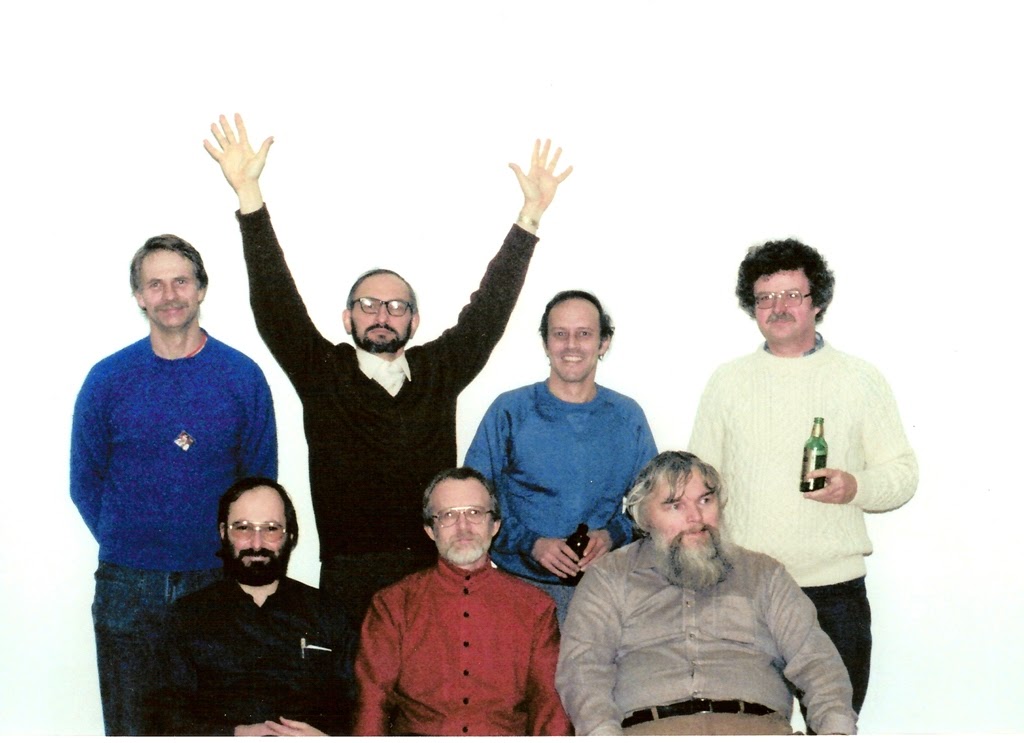
Art Pratten: It is nice to be liked. and it was nice to go to Japan to meet the players and hear what they were doing.
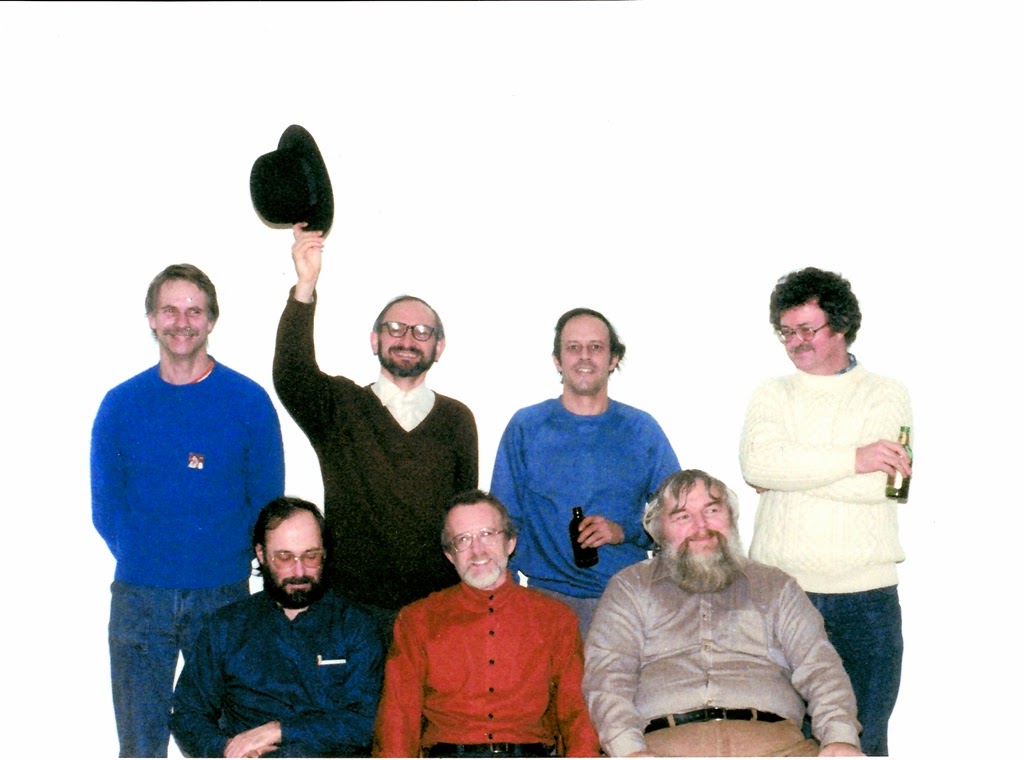
How did the lineup change during the years?
Murray Favro: The only person to quit the band was Archie Leach and he did it around late 1969 so he actually was only in the band for about 5 years. He was about to turn 30 or had already. Archie had told us many times he had a goal to be a millionaire by the time he was 30 and we had not helped with this ambition of his so he wanted his fair share of any money we had put into buying amps. Hugh and I had the task of solving this by not stopping him from quitting the band or making us sell the amps to give him his fair share. A few beers and patience listening he wanted cash, not any band equipment and he settled for a share of the equipment when the band broke up and sold it. Hugh wrote out an agreement for us to sign on a cigarette carton. I’m not sure how legal it all was or if Hugh made two copies. Anyway Archie seems to be OK with the fact we still have not broken up the band.
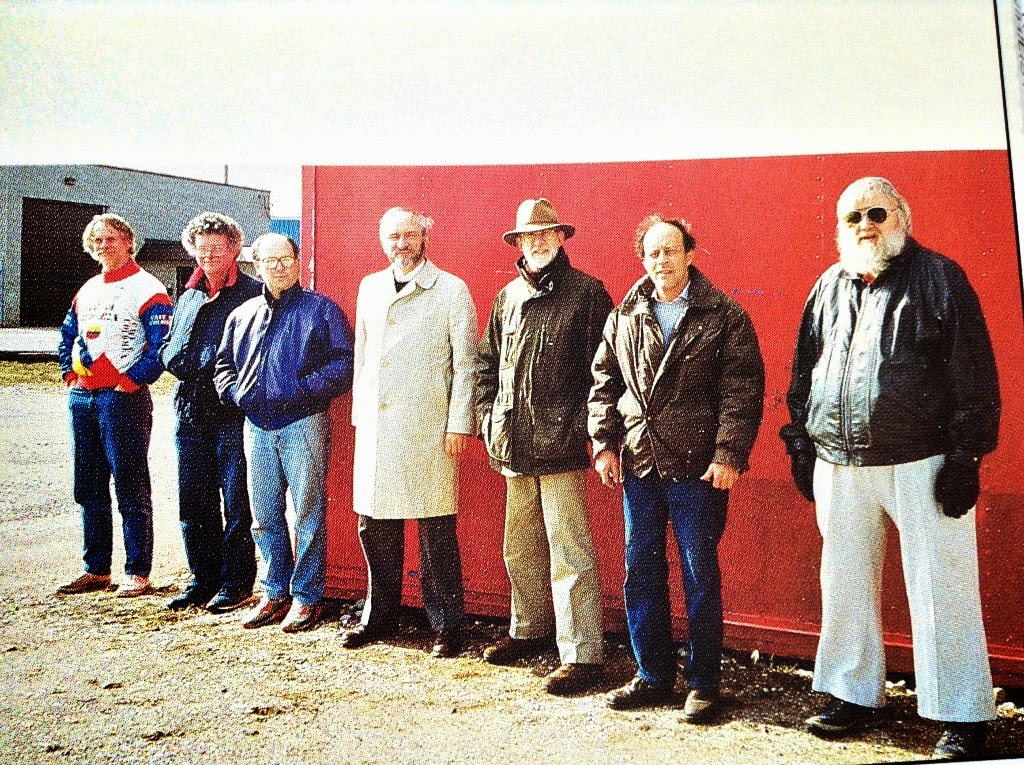
Greg died while riding his bicycle that was hit by a truck about 1995. Hugh died of cancer in about 2008. Aya is now our drummer; we met her in Japan where she organized our tours there. She was truly a fan and sort of followed us back to Canada where she went to university to learn English well enough to be able to dub movies. I was never sure if it was to dub Japanese movies with English or to dub English movies with Japanese. Either way she ended up not dubbing films and marrying John Boyle, now she travels as our drummer to all concerts. She is like a member but wants to stay out of any internal band problems so we have to decide things.
Art Pratten: Archie Leitch left of his own accord, Greg was killed, we picked up Aya Ohnishi in Japan and then Hugh died. I can not imagine adding anyone else. We will probably continue playing til a few more die and the others are not let out.
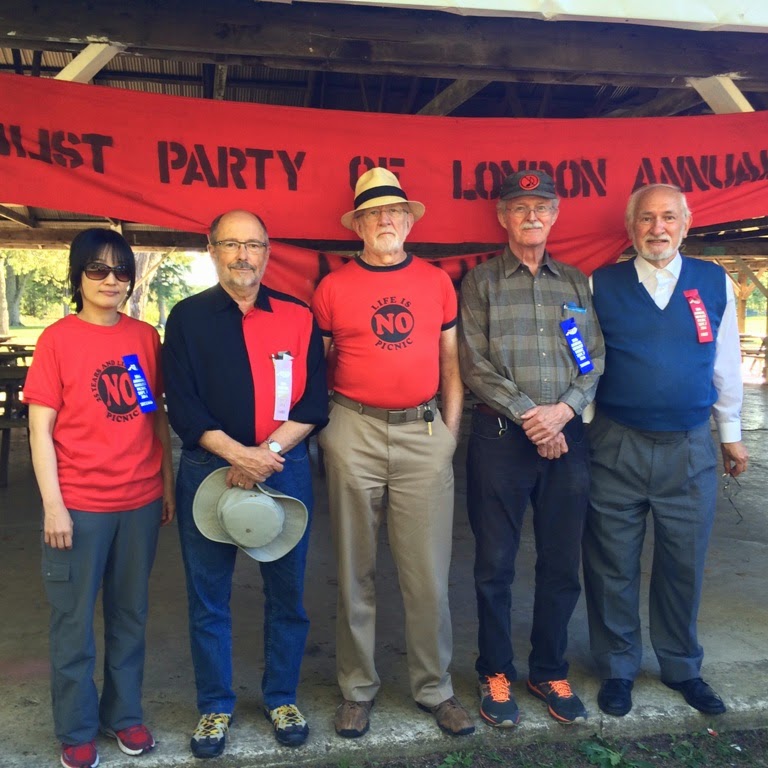
Aya Onishi: When I was fourteen years old in 1984, my school mates and I started the band called Sekiri in which I was the drummer, and that led me to meet Jojo Hiroshige of Hijokaidan, who is the founder of Alchemy Record in Japan. In 1996, I was working at Alchemy Record, and we organized the Spasm Band`s first Japanese tour. During the tour, I sat in with the band and played the drums with them for the first time in my home town, Kyoto, Japan. Later In 1998, I was interested in making subtitles for movies so I decided to go back to school to study English again, and I told Jojo about my plan. He gave me the crazy advice that I should go to a school in London, Ontario, Canada so that I could go to their every Monday night show! I thought it was a brilliant idea so I followed the advice, and ended up being lodged at the Prattens, going to school, and playing with the band every Monday night. I got a chance to make subtitles when the great Canadian filmmaker, the late Zev Asher made a documentary film about the Spasm Band called “What About Me: The Rise of the Nihilist Spasm Band” in 2000, and the film was shown in Tokyo, and Osaka in 2004. Looking back, I did lots of shows, tours, and projects with the band. To me, the sound of the band is unique, curious, and stubborn but never menacing. When we play with great attention to each other`s sounds, it becomes incredible. It sounds alive. When we play like that, that is definitely my favourite moment of the band.
Who is currently in the Nihilist Spasm Band and what currently occupies your life?
Current band members;
Murray Favro (lead guitar)
John Clement (lead bass)
Art Pratten (lead prat-a-various and second fiddle)
Bill Exley (lead vocalist)
John Boyle (Kazoo, drums and lead thumb harp)
Aya Onishi (lead kazoo and lead drummer)
Bill Exley: One of the bad things about getting older is that people fall into attitudes of hostility, narrowness, and lack of intellectual curiosity. I am reading new books, meeting new people, and finding inspiration from people who are young or who have youthful enthusiasm.
Art Pratten: As answered in “What influences you these days?”… Just about everything
Any advice for people who are starting a band?
Murray Favro: Tour as little as needed in a year or your band will break up. We have seen a band with a gig almost every day for months. If you do this just remember familiarity breed’s contempt (says Uncle Hugh). You will hate one another in no time if you overdo it, just do what you can enjoy otherwise your band may last a maximum of 4 or 5 years.
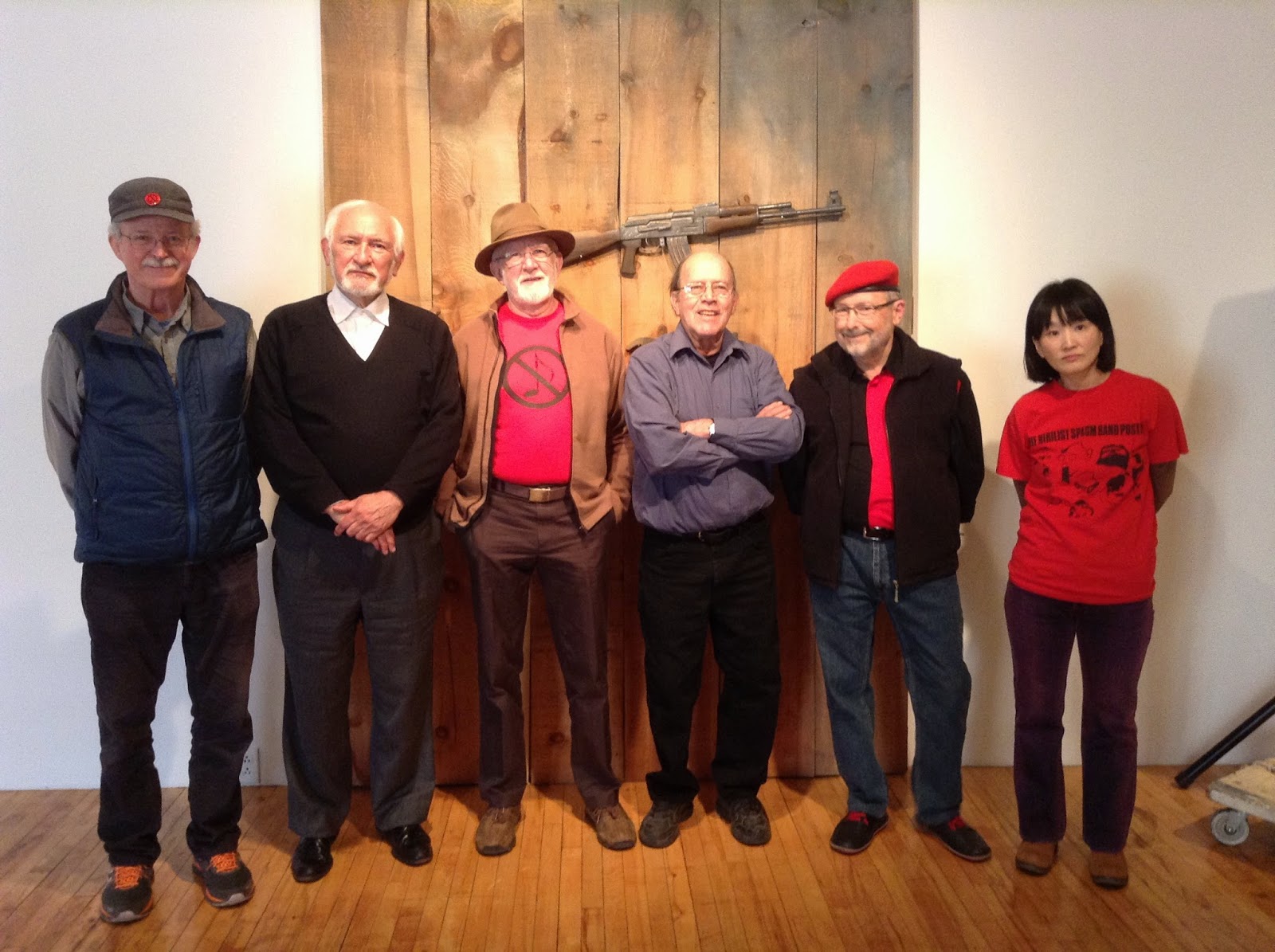
Art Pratten: Be bold’ there will always be people who will be surprised and amused that you have the audacity to put something out there but if you believe in what you are doing they will come to either appreciate what you are doing or at least respect you for doing it. But remember… this is for you, your vision comes first.
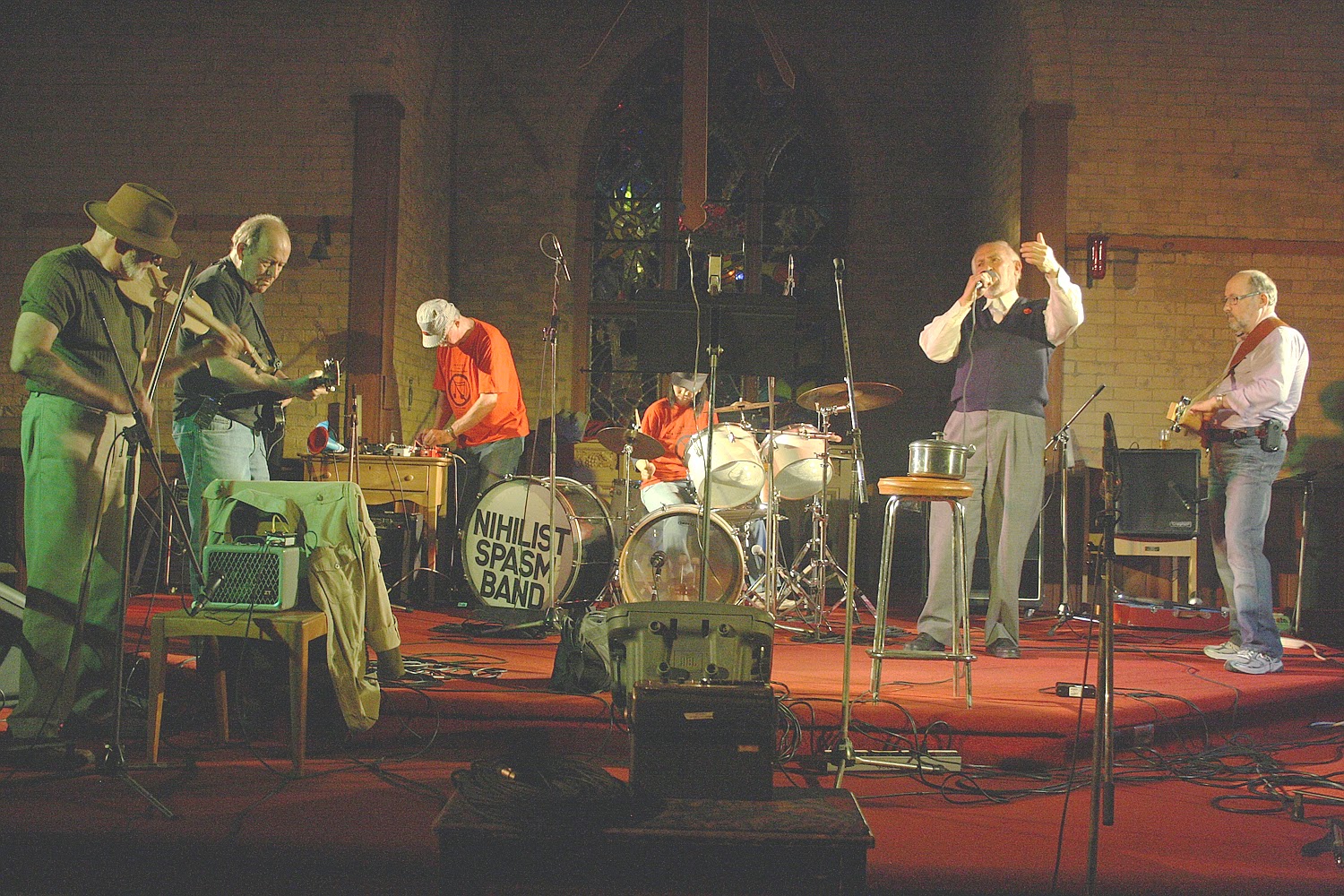
Thank you!
Thanks Klemen.
Headline photo: The Nihilist Spasm Band in 1968 at York Hotel. They played every Monday night in their pub for several years | L to R: Hugh McIntyre (bass), Art Pratten (Pratt-A-Various), Archie Leitch (slide clarinet), Murray Favro (guitar and drums), John Clement (guitar), Bill Exley (vocals and theremin), John Boyle (kazoo), Greg Curnoe (kazoo and drums) | Photo by Ian MacEachern

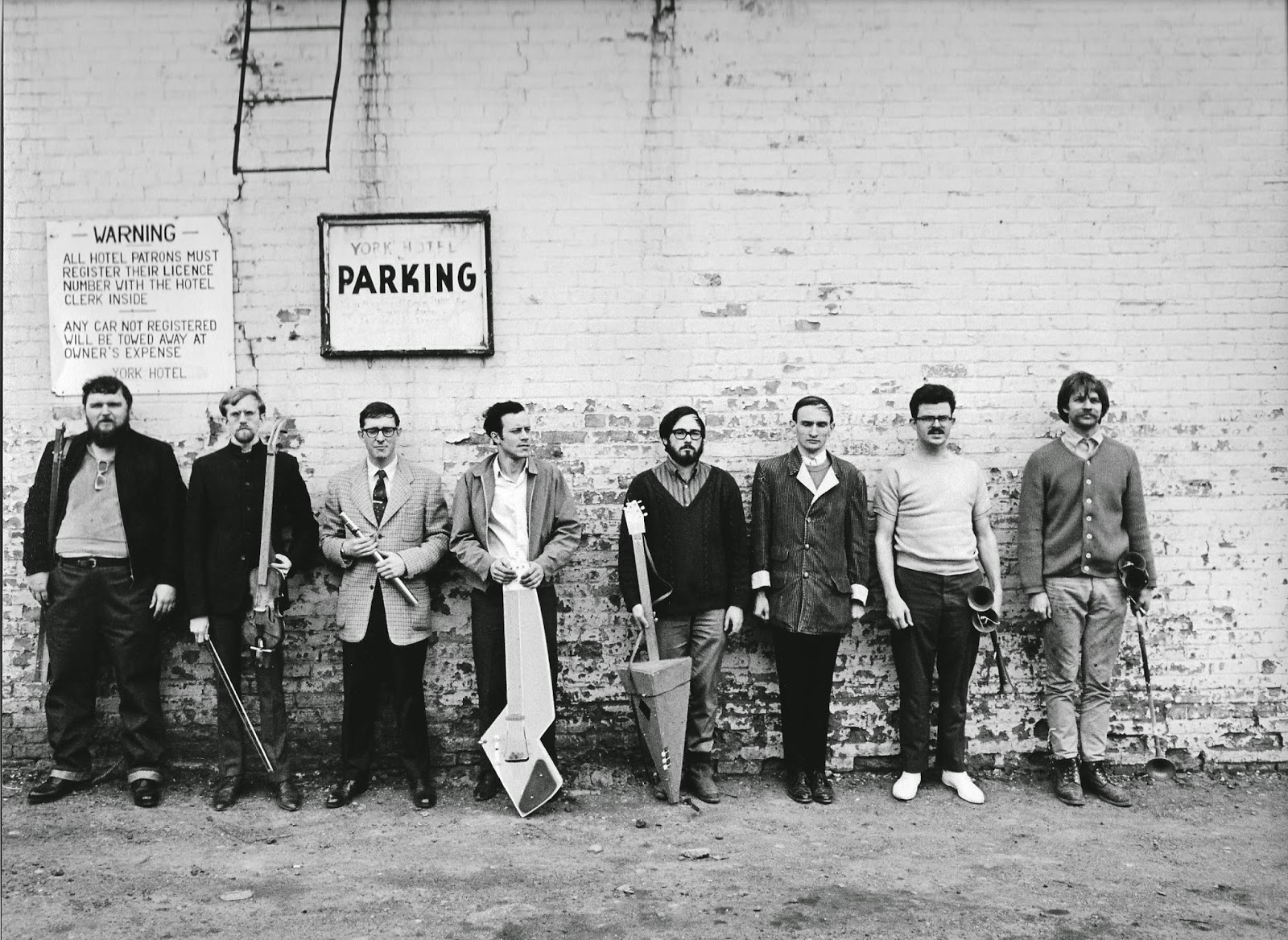



Absolutely brilliant interview. Awesome.